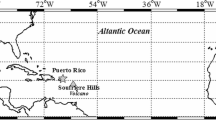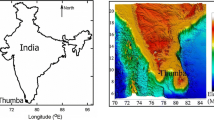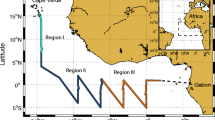Abstract
Marine aerosol samples collected from the western North to equatorial Pacific Ocean (16°S–35°N, 140°E–150°W), were studied for total carbon (TC: 0.069–5.27 μgm−3, ay. 0.39 μgm−3) and nitrogen (TN: 0.026–1.44 μgm−3, ay. 0.12 μgm−3) contents employing an elemental analyzer. Homologous series of dicarboxylic acids (C2–C10) and w-oxocarboxylic acids (C2–C9) in the aerosols were determined by capillary gas chromatography (GC) and GC/mass spectrometer (GC/MS). Their molecular distributions indicated a predominance of oxalic acid (C2) and glyoxylic acid (C2). The concentrations of total diacids and ω-oxoacids were 10–250 ngm −3 (ay. 63 ngm−3) and 0.333.3 ngm−3 (ay. 3.4 ngm−3), respectively. The dicarboxylic acids showed a spatial distribution with higher concentrations in the western North Pacific region and lower concentrations in the central tropical Pacific. Relative abundances of total diacid carbon in TC, however, were highest (up to 16%) in the central equatorial Pacific, suggesting that small diacids are secondarily produced in the remote marine atmosphere. Further, ω-oxoacids were also abundant in the western North and tropical Pacific. In the remote marine atmosphere, oxalic acid and glyoxylic acid are likely produced by oxidative chain reactions occurring in the gaseous and particulate organic compounds which are transported long distances from the Asian continent.
Access this chapter
Tax calculation will be finalised at checkout
Purchases are for personal use only
Preview
Unable to display preview. Download preview PDF.
Similar content being viewed by others
References
Bandow, H. and N. Washida (1985): Ring-cleavage reactions of aromatic hydrocarbons studied by FTIR spectroscopy II. Photooxidation of o-, m-, and p-xylenes in the NOS-air system. Bull. Chem. Soc. Jpn., 58, 2541–2548.
Bandow, H., N. Washida and H. Akimoto (1985): Ring-cleavage reactions of aromatic hydrocarbons studied by FTIR spectroscopy. I. Photooxidation of toluene and benzene in the NO,-air system. Bull. Chem. Soc. Jpn., 58, 2531–2540.
Gagosian, R. B. (1986): The air-sea exchange of particulate organic matter: The sources and long-range transport of lipids in aerosols. pp. 409–442. In The Role of Air-Sea Exchange in Geochemical Cycling, ed. by P. Buart-Menard, D.Reidel, Dordrecht, The Netherlands.
Grosjean, D., K. Van Cauwenberghe, J. P. Schmid, P. E. Kelley and J. N. Pitts, Jr. (1978): Identification of C3—C10 aliphatic dicarboxylic acids in airborne particulate matter. Environ. Sci. Technol., 12, 313–317.
Hatakeyama, S., M. Ohno, J. Weng, H. Takagi and H. Akimoto (1987): Mechanism for the formation of gaseous and particulate products from ozone-cycloalkene reactions in air. Environ. Sci. Technol., 21, 52–57.
Imai, Y. and K. Kawamura (1996): Distributions and seasonal variations of dicarboxylic acids, ketocarboxylic acids and dicarbonyls in rain, snow and aerosols in Tokyo. Res. Org. Geochem., 11, 61–66.
Kawamura, K. (1993): Identification of C2—C10 w-oxocarboxylic acids, pyruvic acid and C2—C3 adicarbonyls in wet precipitation and aerosol samples by capillary GC and GC/MS. Anal. Chem., 65, 3505–3511.
Kawamura, K. (1995): Land-derived lipid class compounds in the deep-sea sediments and marine aerosols from North Pacific. pp. 31–51. In Biogeochemical Processes and Ocean Flux in the Western Pacific, ed. by H. Sakai and Y. Nozaki, Terrapub, Tokyo.
Kawamura, K. and R. B. Gagosian (1987): Implications of co-oxocarboxylic acids in the remote marine atmosphere for photo-oxidation of unsaturated fatty acids. Nature, 325, 330–332.
Kawamura, K. and R. B. Gagosian (1990): Mid-chain ketocarboxylic acids in the remote marine atmosphere: distribution patterns and possible formation mechanisms. J. Atmos. Chem., 11, 107–122.
Kawamura, K. and K. Ikushima (1993): Seasonal changes in the distribution of dicarboxylic acids in the urban atmosphere. Environ. Sci. Technol., 27, 2227–2235.
Kawamura, K. and I. R. Kaplan (1987): Motor exhaust emissions as a primary source for dicarboxylic acids in Los Angels ambient air. Environ. Sci. Technol., 21, 105–110.
Kawamura, K. and K. Usukura (1993): Distributions of low molecular weight dicarboxylic acids in the North Pacific aerosol samples. J. Oceanogr., 49, 271–283.
Kawamura, K., H. Kasukabe, O. Yasui and L. A. Barrie (1995a): Production of dicarboxylic acids in the arctic atmosphere at polar sunrise. Geophys. Res. Lett., 22, 1253–1256.
Kawamura, K., M. Kosaka and R. Sempéré (19956): Distributions and seasonal changes of hydrocarbons in urban aerosols and rainwaters. Chikyukagaku (Geochemistry), 29, 1–15.
Kawamura, K., R. Sempéré, Y. Imai, M. Hayashi and Y. Fujii (1996a), Water soluble dicarboxylic acids and related compounds in the Antarctic aerosols. J. Geophys. Res., D13, 18,721–18, 728.
Kawamura, K., S. Steinberg and I. R. Kaplan (1996b): Concentrations of monocarboxylic and dicarboxylic acids and aldehydes in southern California wet precipitations: Comparison of urban and nonurban samples and compositional changes during scavenging. Atmos. Environ., 30, 1035–1052.
Li, S. M. and J. W. Winchester (1993): Water soluble organic constituents in arctic aerosols and snow pack. Geophys. Res. Lett., 20, 45–48.
Li, X., H. Maring, D. Savoie, K. Voss and J. M. Prospero (1996): Dominance of mineral dust in aerosol light-scattering in the North Atlantic trade winds. Nature, 380, 416–419.
Nishikiori, M., K. Kawamura, M. Hayashi and Y. Fujii (1996): Mono-and di-carboxylic acids and mid-chain oxocarboxylic acids in the Antarctic aerosols. Chikyukagaku (Geochemistry), 30, 27–34.
Novakov, T. and J. E. Penner (1993): Large contribution of organic aerosols to cloud-condensationnuclei concentrations. Nature, 365, 823–826.
Norton, R. B., J. M. Roberts and B. J. Huebert (1983): Tropospheric oxalate. Geophys. Res. Lett., 10, 517–520.
Sakaguchi, F. and K. Kawamura (1994): Identification of 4-oxoheptanedioic acid in the marine atmosphere by capillary gas chromatography-mass spectrometry. J. Chromatogr. A, 687, 315–321.
Satsumabayashi, H. H. Kurita, Y. Yokouchi and H. Ueda (1990): Photochemical formation of particulate dicarboxylic acids under long-range transport in central Japan. Atmos. Environ.,24A 1443–1450.
Saxena, P. and L. M. Hildemann (1996): Water-soluble organics in atmospheric particles: A critical review of the literature and application of thermodynamics to identify candidate compounds. J. Atmos. Chem., 24, 5–109.
Saxena, P., L. M. Hildemann, P. H. McMurry and J. H. Seinfeld (1995): Organics alter hygroscopic behavior of atmospheric particles. J. Geophys. Res., 100, 18755–18770.
Sempéré, R. and K. Kawamura (1994): Comparative distributions of dicarboxylic acids and related polar compounds in snow, rain and aerosols from urban atmosphere. Atmos. Environ., 28, 449–459.
Sempéré, R. and K. Kawamura (1996): Low molecular weight dicarboxylic acids and related polar compounds in the remote marine rain samples collected from western Pacific. Atmos. Environ., 30, 1609–1619.
Simoneit, B. R. T., R. Chester and G. Eglinton (1977): Biogenic lipids in particulates from the lower atmosphere over the eastern Atlantic. Nature, 267, 682–685.
Uematsu, M., K. Kawamura, T. Ibusuki and T. Kimoto (1995): Chemical composition of marine aerosols over the Central North Pacific. Results from the 1991 cruise of Hakurei Maru No. 2. pp. 3–14. In Biogeochemical Processes and Ocean Flux in the Western Pacific, ed. by H. Sakai and Y. Nozaki, Terrapub, Tokyo.
Warneck, P. (1988): Chemistry of the Natural Atmosphere. Academic Press, New York, 757 pp.
Tegen, I., A. A. Lacis and I. Fung (1996): The influence on climate forcing of mineral aerosols from disturbed soils. Nature, 380, 419–422.
Yokouchi, Y. and Y. Ambe (1986): Characterization of polar organics in air borne particulate matter. Atmos. Environ., 20, 1727–1734.
Author information
Authors and Affiliations
Editor information
Editors and Affiliations
Rights and permissions
Copyright information
© 2000 Springer Science+Business Media Dordrecht
About this chapter
Cite this chapter
Kawamura, K. (2000). Total Carbon and Nitrogen Contents and Molecular Composition of Water Soluble Organic Matter in the Marine Aerosols from Western North to Tropical Central Pacific. In: Handa, N., Tanoue, E., Hama, T. (eds) Dynamics and Characterization of Marine Organic Matter. Ocean Sciences Research (OSR), vol 2. Springer, Dordrecht. https://doi.org/10.1007/978-94-017-1319-1_19
Download citation
DOI: https://doi.org/10.1007/978-94-017-1319-1_19
Publisher Name: Springer, Dordrecht
Print ISBN: 978-90-481-5451-7
Online ISBN: 978-94-017-1319-1
eBook Packages: Springer Book Archive




